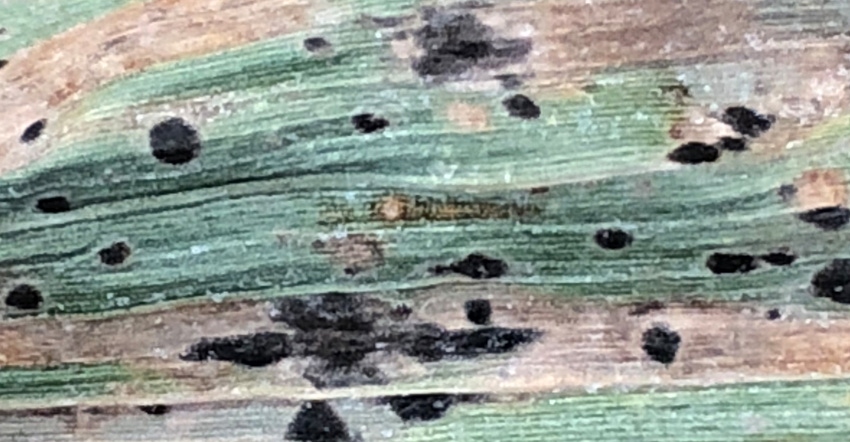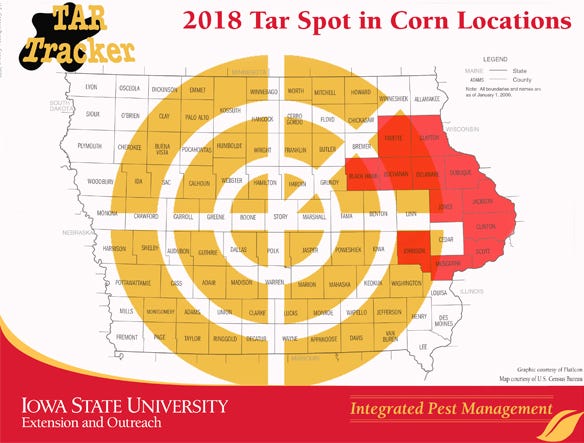October 11, 2018

By Ethan Stoetzer
Cases of tar spot, a leaf disease of corn, have been reported late in the growing season in 12 Iowa counties this year. Iowa State University Extension plant pathologists have been able to confirm the presence of tar spot in four counties via the ISU Plant and Insect Diagnostic Clinic at Ames.
Agronomists and collaborators have confirmed the remaining cases throughout the state. The current counties with confirmed tar spot presence include Jones, Jackson, Johnson, Muscatine, Fayette, Clayton, Black Hawk, Buchanan, Delaware, Dubuque, Clinton, Scott, Grundy and Chickasaw counties.
Knowledge of yield impacts of tar spot in corn is limited. In Mexico and Latin America, tar spot, caused by the fungus Phyllachora maydis, does not affect yield. However, if P. maydis co-infects with another fungus, Monographella maydis, causing a tar spot complex, then substantial yield loss may occur.
To date, M. maydis has not been reported in the continental U.S. However, University of Wisconsin plant pathologists have suggested that P. maydis can form a complex with other organisms present in the Midwest, and the impacts of these complexes are unknown.

NEW CORN DISEASE: Tar spot on corn has been documented in some fields in a dozen counties in eastern Iowa this year.

Tar spot in corn was first confirmed in the U.S. in 2015 in Illinois and Indiana. The disease was first reported in eastern Iowa in 2016, the same year it was detected in Michigan and Florida. Since then, the disease has been reported each growing season, which suggests that the fungus is overwintering in the Midwest. Reports of tar spot in eastern Iowa in 2018 have been received late in the grain filling stage, and the severity of this disease in most fields is low.
Symptoms to look for
Tar spot in corn is recognized as small, raised, black irregular-shaped spots scattered across the leaf surface. These spots are fruiting structures of the fungus, known as ascomata P. maydis.
If a small section of the leaf is viewed under a microscope, hundreds of sausage-shaped spores are visible.
As with most diseases, tar spot does have look-a-likes — namely, common and southern rust. At the end of the growing season, both rust fungi switch from producing orange-red spores to black spores. Rust pustules filled with spores can be mistaken for tar spot.
Tar spot often confused with rust
Remember, the rust spores burst through the epidermis and the spores can be scraped away from the pustules with a fingernail. Tar spots cannot be scraped off the leaf tissue.
Researchers postulate that the pathogen is spread via wind and rain water. It has been proposed that spores of the pathogen arrived in the U.S. in a storm that originated in Mexico and Latin America.
If you have observed corn with tar spot symptoms, notify Extension plant pathologists Alison Robertson or Ed Zaworski, or tweet at @isu_ipm, with a photo (if possible) and the name of the county in which the disease was found. That will help ISU plant pathologists continue to add to their database and keep track of the disease in Iowa.
Stoetzer is a communications specialist with the Integrated Pest Management program at Iowa State University.
You May Also Like




